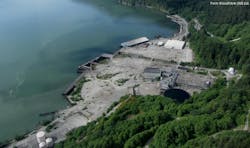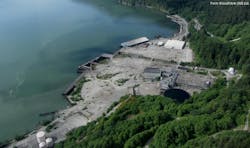Woodfibre LNG lets contract for proposed British Columbia project
Pacific Oil & Gas Ltd. subsidiary Woodfibre LNG Ltd., Vancouver, BC, through a contractor, has let a contract to Flour Corp. to provide construction-related support to front-end engineering and design services for Woodfibre LNG’s proposed 2.1-million tonne/year liquefaction plant and export terminal near Squamish, BC, on the northwestern shoreline of Howe Sound.
Under the subcontract, Fluor will deliver construction planning and design services to support the LNG project’s FEED package and engineering, procurement, and construction proposal development currently under way by JGC Corp. of Japan subsidiary JGC America Inc., Fluor said.
Flour, which confirmed booking the order during fourth-quarter 2016, did not disclose a precise value of the contract.
This latest contract follows a previous contract to JGC America for delivery of FEED services and an EPC proposal on the planned project, which Woodfibre LNG awarded during fourth-quarter 2016, according to an Oct. 25, 2016, release from JGC.
In 2014, Woodfibre LNG also let a contract to Germany’s Linde Group to provide engineering and procurement services for the project’s LNG plant, which, at the time, was to be equipped with Linde’s proprietary multistage mixed refrigerant Limum process technology and in operation by yearend 2017 (OGJ Online, Sept. 12, 2014).
Project update
Previously approved by Canada’s National Energy Board in December 2013 for a license to allow LNG exports from the proposed project for 25 years, Woodfibre LNG recently applied for a 40-year export license following 2015 amendments to NEB regulations that increased the allowable maximum term for LNG export licensing, the company said.
Woodfibre LNG also has submitted an application to British Columbia’s Environmental Assessment Office to amend the project’s existing environmental assessment certificate, which—initially granted by EAO on Oct. 25, 2015—allows the company to build and operate the LNG plant and export terminal, Woodfibre LNG said.
Resulting from consultation with the Squamish Nation—a local indigenous group—as well ongoing FEED work, the EAO amendments involve proposed design changes to the project, including:
• Using air to cool the LNG plant rather than seawater.
• Upgrading an existing water intake on Mill Creek rather than constructing a new intake.
• Using water from Woodfibre Creek on a short-term basis during construction while water from Mill Creek is unavailable.
Both the export licensing application and proposed EAO amendments will be available for public comment through early March, the company said.
Pending all necessary regulatory approvals for NEB licensing, EAO amendments, and other outstanding federal and local permits, construction could begin in earnest by yearend for a targeted startup sometime in 2020, POG said in a Nov. 4, 2016, announcing it had reached final investment decision on the LNG project.
If realized, the LNG plant—which will be built on an industrial-zoned brownfield site with an existing deepwater port, on a waterway already used for commercial shipping—would receive natural gas from FortisBC's proposed Eagle Mountain–Woodfibre gas pipeline project, a 47-km expansion of its existing system that would run from north of the Coquitlam watershed to Woodfibre LNG’s planned project.
Capital costs to complete proposed LNG plant and export project, including 250,000 cu m of planned storage at the site, will run between $1.4-1.8 billion (Can.), Woodfibre LNG said in a Jan. 18 presentation to stakeholders.
Contact Robert Brelsford at [email protected].

